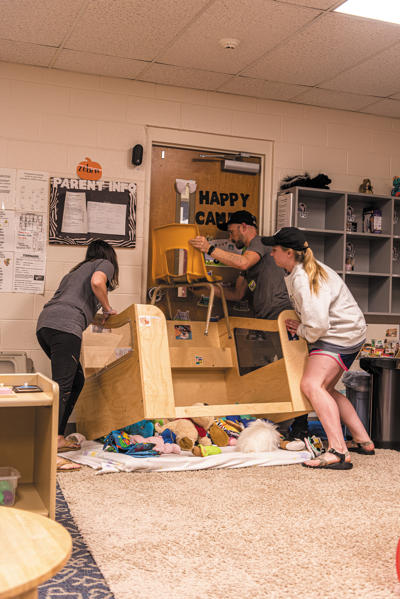
Teachers barricade a door during a training exercise
Sarah Beth Deweese, Anna Laurenzo and Matt Walberg are three teachers with one goal: to barricade the door with as much furniture as possible, and keep it from opening. They have a host of options available to them in the classroom, which is typically full of 1-year-old children. There are no kids present on this Saturday morning, but there is a table the teachers could use, as well as a changing station. They can’t rely on the lock and hope a well-placed chair leg will keep the door handle in place — it opens outward. They pile obstacles against the door and cover its window, and then they hide in a closet.
The door opens — the chair failing to jam the handle — and retired police officer Ron Roszak peeks through the barricade. The teachers exit the closet. The drill is over.
Roszak is with the Institute for Childhood Preparedness, which visited Calvary United Methodist Church in Green Hills on July 13 to train early-childhood teachers for active-shooter emergencies. Roszak says the teachers did a good job: A gunman is unlikely to climb over the barricade. But they still need a way to keep the door closed. He leaves, and the three search for objects that could help jam the door. They have good ideas of where to look — all three teach at Calvary UMC’s preschool, and Deweese and Laurenzo work in this very classroom. They focus on jamming up the folding V-shaped mechanism at the top of the doorway. They find a sleeve that fits over the mechanism and then stick an umbrella through the remaining gap. They also re-evaluate where to hide the children: The closet works, but one corner of the room offers both protection and an escape route.
When Roszak returns, the door barely opens. The improvised wedge is successful.
Drills like these have grown common since the 1999 shooting at Columbine High School in Colorado, spiking after more recent incidents like the 2012 shooting at Sandy Hook Elementary School. Now 42 states, including Tennessee, have laws requiring that schools hold at least one active-shooter drill per school year.
The top recommended method for these drills, according to the National Association of School Psychologists, is the lockdown procedure, in which staff members lock the door, shut the blinds and hide. But more controversial strategies have emerged in recent years, with options to flee or fight back in case a lockdown isn’t possible — “ALICE” and “Run, Hide, Fight” are among the best-known. Sometimes the drills for these options-based approaches involve pellet guns or blanks, which has sparked concerns about traumatizing students and staff alike.
NASP says all active-shooter drills should take precautions to avoid traumatizing participants, offering guidelines for protecting participants’ mental health.
Safety experts question the effectiveness of many drills. James Allen Fox, a Northeastern University criminologist, recently told NBC that it could be more effective to train only teachers and not their students. The president of National School Safety and Security Services warned Education Week that multi-options drills may pass along unproven ideas, and the executive director of Safe Havens International told Emergency Management magazine that teachers with Run, Hide, Fight experience performed worse in safety drills than those with no training.
Currently, even kindergarteners experience drills. NASP recommends age-appropriate language for small children: Say they’re building a fort, hiding from a wild animal, or avoiding a stranger. There’s a lockdown nursery rhyme to the tune of “Twinkle, Twinkle, Little Star” that prompted a wave of online responses after being used in a Massachusetts school last year. “Lockdown, lockdown, lock the door,” went the rhyme, “shut the lights off, say no more.”
Although school shootings generate massive amounts of media coverage and are far more common in the U.S. than in any other country, these events are very rare, statistically speaking: One percent of all student deaths occur at the hands of armed assailants.
“You’re much more likely to be struck by lightning than you are to be in an armed-intruder event in a school,” says Cathy Paine, a coordinator for NASP’s direct school crisis response team, adding that schools need to balance safety drills with the likelihood of any given emergency.
According to NASP, the lockdown method is the only technique proven to work. Paine says this is based on evaluations from shootings like the one last year in Parkland, Fla., during which students who secured themselves in classrooms stayed safe.
While options-based methods still include lockdowns, they also sometimes involve physical drills that lead to injuries and trauma.
During an ALICE-style training — ALICE is an acronym for “Alert, Lockdown, Inform, Counter and Evacuate” — at an Indiana elementary school, teachers were lined up against the wall and shot across their backs with air pellets, without warning. They reported bruises and bleeding. After news of the incident spread, teachers pushed to modify state law to prohibit the use of projectiles in active-shooter drills, but it didn’t happen. One prominent critic of using projectiles was Jason Seaman, an Indiana teacher who stopped an armed student by throwing a basketball at the gun and tackling him.
“You shouldn’t have to shoot at teachers to train them,” Teresa Meredith, president of the Indiana State Teachers Association, tells the Scene.
NASP doesn’t condemn the use of projectiles, but the group says it’s important to announce the use of such props. In fact, the organization stresses that all active-shooter drills should be announced.
Activists like Parkland shooting survivor David Hogg have stressed the need to pass gun-control measures over staging active-shooter drills, but such gun laws are nowhere in sight.
“I think it’s sad that we have to do [these drills], given our current affairs in this country,” says Paine. But she does think such training offers “lifelong skills,” since shootings can also happen outside of schools.
The Institute for Childhood Preparedness doesn’t use projectiles and doesn’t replicate a full ALICE experience.
“We’ve always thought that ALICE was a little too intense and just too scary, quite honestly, for folks,” Andrew Roszak, founder of the Institute for Childhood Preparedness and Ron Roszak’s son, tells the Scene. He has 20 years of emergency preparedness experience, and developed the institute after noticing a lack of training for early-childhood teachers and caretakers.
He says staffers at the institute read papers from NASP and other organizations while developing their curriculum. The Nashville training event on this recent Saturday morning did not involve children, but Roszak says students have participated in past events, and he echoes NASP’s instructions on making such drills age-appropriate.
The barricade drill took up only the last 30 minutes of Saturday’s three-hour session. The bulk was a seminar featuring a slideshow and various videos that sought to demonstrate the best strategies for when to hide, run away or confront a shooter, with an emphasis on adapting to changing circumstances. Videos included Diane Sawyer’s interview with a Sandy Hook teacher who successfully hid her classroom from the shooter, as well as security footage of a gunman rampaging through a department store, killing five people.
The United Methodist Association of Preschools brought the Institute for Childhood Preparedness reps to Nashville, and about 40 UMAP teachers from the region attended that morning, with a second session open to the public in the afternoon. For the practice drill, the attendees split into three groups, with teachers at Calvary UMC’s preschool getting trained in their own classrooms.
The Calvary UMC teachers responded well to the drill after its conclusion, saying that while they’d received some training before, this was a more in-depth experience.
Deweese later tells the Scene she found the training “extremely helpful,” and while it was a bit intense, she felt safe and comfortable with it.
“As a child care teacher, it’s a very rewarding job, and our job is to keep these children safe when they’re in our care, and having a training like this is very valuable,” she says. “It’s good to know how to protect them and ourselves.”





